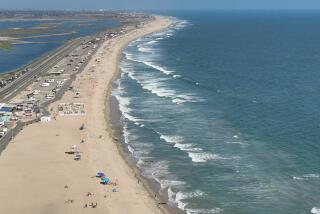FOCUS : College Park East’s Name Stands Test of Time
- Share via
When it came time to name this north Seal Beach neighborhood, developers S & S (Shapell & Shapell) must have been feeling a trifle whimsical. A name like College Park East would seem to indicate the presence of, well, a college--something on the lines of College Park, Md., home of the University of Maryland. But here there is no institution of higher learning closer than Cal State Long Beach.
But the name has at least stood the test of time. The then-unincorporated area was annexed to the city of Seal Beach in 1964, according to City Clerk Joanne Yeo, and the first houses were built in 1966 with construction continuing through 1973.
Houses in this quiet residential area are modest, and lawns are well-tended. At times the landscaping--including cactus, small palms, willow trees and flowers such as roses, marigolds and Vinca--is showier than the houses it fronts. As Fir Avenue intersects Wisteria Street, the variety of evergreens in evidence--pines, Douglas firs and cedars--gives credence to the avenue’s name.
City Council member and schoolteacher Frank Laszlo, one of the original residents of the neighborhood, has lived there for 20 years.
“It’s a very nice area . . . an affluent area, (whose residents are) doctors, airline pilots, dentists, businessmen, attorneys, teachers,” Laszlo says. Laszlo’s observations are backed by economic data. The neighborhood has a median household income in excess of $65,000, high even by Orange County standards. Three households in four have an annual income of $50,000 or more. “It’s a desirable location, very close to the freeway, close to Los Angeles, a couple of miles from the beach,” he adds.
At one point, about 50% of the residents drove to Los Angeles to work; now the number of commuters is down to 40%. Some residents have jobs in Long Beach, and others “are beginning to go to Orange County (to work)--and complain about traffic,” Laszlo says.
“It’s a good area to raise a family,” he continues. “The school system, Los Alamitos, is one of the best in the county. A lot of families have moved in (recently) with a lot of kids.” He’s surprised that young families can afford the current house prices.
Housing prices here are an echo of the rest of the county. A three-bedroom house originally sold for $27,000. Homes with three to six bedrooms now fetch $300,000 to $500,000 and up. A four-bedroom home that cost $32,000 20 years ago would now sell for more than $350,000. A two-story structure that originally sold for $36,000 is now worth more than $450,000.
Children cavort at the small playground at Shapell Park, on the corner of Almond Avenue and Oleander Street. The children’s play site at Heather Park, on Hazelnut Avenue between Heather and Iris streets, features such amenities as tennis courts, a children’s tree house and a softball field.
The neighborhood’s proximity to the Armed Forces Reserve Center has posed no problems, Laszlo says. “Helicopters do fly outside the area, but citizens are used to it and have no complaints. . . . The majority coexist with the air station fairly well.”
A focal point of physical and social activity, the Old Ranch Golf Country Club and Tennis Club, lies west of the residential community proper. And the name is no exercise in needless conceit, for it actually comprises two exclusive private clubs, one for golf and one for tennis.
To join, one must be sponsored by a member and be seconded by another. The initiation fee for a golf membership is $20,000; monthly dues are $200. Even at those rates, there is a waiting list. “The majority of the members come from Long Beach, Seal Beach and Huntington Beach,” says Bill Elvins, manager of the golf club.
It is not mandatory that a prospective member have a sponsor to join the tennis club, according to manager Bob Litrich. The initiation fee is $600; monthly fees vary from $85 to $100 depending on the type of membership. Some members belong to both clubs.
Social memberships, when they are available (they are currently sold out), feature the use of the clubhouse, food and beverages, and club social events. The initiation fee and monthly dues are a more modest $125 and $65, respectively.
The neighborhood has its share of individually owned condominiums between Old Ranch Road and Lampson Avenue. Prices for condominiums were sometimes higher than the price for houses: When houses were selling for $280,000, condominiums were on the market for $285,000 to $290,000.
More than the condos’ prices were controversial. Their construction stirred trouble between residents of College Park East and developers. “Citizens wanted the area to be a park site,” Laszlo says. “The city government didn’t quite understand our position, and (we) took the vote to the people,” but their efforts to block the construction failed.
The misunderstanding is perhaps understandable with a look at a map. The San Diego Freeway divides the neighborhood from the bulk of the city, giving it a bit of a separatist mentality.
“College Park East is a little bit more politically aggressive (than the rest of Seal Beach) at times. It’s north of the freeway. We hope to get along a little bit better” in the future, Laszlo says.
Population Total: (1989 est.) 5,782 1980-89 change: +0.8% Median Age: 40.8
Racial/ethnic mix: White (non-Latino), 83%; Latino, 6%; Black, 2%; Other, 9%
By sex and age: MALES Median age: 39.8 years FEMALES Median age: 41.4 years
Income Per capita: $22,453 Median household: $65,716 Average household: $69,408
Income Distribution: Less than $25,000: 4% $25,000-49,999: 24% $50,000-74,999: 35% More than $75,000: 37%
More to Read
Sign up for Essential California
The most important California stories and recommendations in your inbox every morning.
You may occasionally receive promotional content from the Los Angeles Times.








